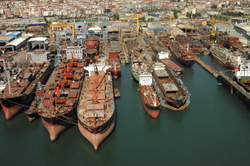Union of Zorasani Irfanic Republics
Economy
As of 2019, Zorasan had the 9th largest economy by GDP nominal, with $1.809 trillion and the 13th largest economy by GDP PPP with $2.250 trillion. The Global Institute for Fiscal Affairs classifies Zorasan as a newly industrialised nation and a middle-income economy. The country operates an economic model many have described as state capitalist, with heavy state intervention and ownership alongside private businesses. Following initial pro-market reforms beginning 1985 and more expansive reforms throughout the 1990s, the Zorasani economy became one of the fastest growing in the developing world, with GDP growth remaining above 6 percent from 1991 to 2001, before growing consistently above 8 percent from 2009 onward. The most prominent sectors of the Zorasani economy are Industry, 41.45%, petrochemicals 29.5%, services 25% and agriculture 4.05%.
Since 1980, the structure and nature of the economy has changed considerably. Upon the Union's founding 1980, its newly unified economy was dominated by agriculture and petrochemicals, owing to both the reliance on petrochemicals for revenue of pre-unification states and their shared aims of promoting agricultural self-sufficiency. The degree of development varied between the states, though all were historically recognised as rentier economies. Following the completion of unification and the inescapable need to rebuild entire regions owing to near thirty-years of warfare saw a significant shift in economic planning and strategy. In 1980, the Zorasani government recognised the limitations of oil-dependency and sought to dramatically diversify the economy, both as a means of escaping rentier status and to provide greater means of improved living standards for the entire population. Throughout the 1980s, high oil prices and the consolidation of the unified oil industries - turning Zorasan into the largest producer of petrochemicals in the world, supplied the government with the necessary capital to invest into manufacturing and services. The industrialisation process was aided by urbanisation, which further fuelled diverisification and infrastructure development. This development continued throughout the 1990s, during which the GDP rose at an average rate of 9.1%. As a result, the official poverty rate fell from 60% to 15%. Reduction of trade barriers from the mid-1990s made the economy more globally integrated. A series of pro-market reforms in the late 1990s expanded competitiveness and hastened diversification, however, more radical reforms in the early 2000s caused a sharp economic shock, combined with privatisation of ineffecient state owned enterprises threw the economy into recession, which was deepened by the onset of the 2005 Global Recession. Political instability between 2005 and 2006 slowed recovery, before growth returned to its 9% average in 2007, which has been maintained since.



